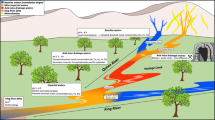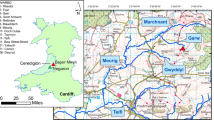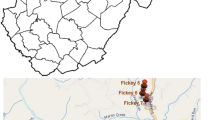Abstract
Contaminated drainage from metal mines is a serious water-quality problem facing nations that exploit metal mineral resources. Measurements of river hydrochemistry during baseflow are common at mine sites, whilst detailed hydrochemical information regarding stormflow is limited and often confined to a single event. This study investigates the seasonal evolution of stormflow hydrochemistry at an abandoned metal mine in central Wales, UK, and the possible sources and mechanisms of metal release. Significant flushing of metals was observed during stormflow events, resulting in concentrations that severely exceeded water-quality guidelines. The relationship between metal concentrations and river discharge suggests dissolution of efflorescent metal sulphates on the surface of the mine spoil as the principal source of the contamination. High fluxes of Pb during stormflows are linked to extended periods of dry weather prior to storm events that produced water table drawdown and encouraged oxidation of Pb sulphide in the mine spoil. However, some Pb flushing also occurred following wet antecedent conditions. It is suggested that Fe oxide reduction in mine spoil and translatory flows involving metal-rich pore waters results in flushing during wetter periods. Detailed measurements of stormflow hydrochemistry at mine sites are essential for accurate forecasting of long-term trends in metals flux to understand metal sources and mechanisms of release, to assess potential risks to water quality and instream ecology, and to gauge the potential effectiveness of remediation. In order to protect riverine and riparian ecosystems, it is suggested that routine monitoring of stormflows becomes part of catchment management in mining-impacted regions.




Similar content being viewed by others
References
Ali, G. A., & Roy, A. G. (2010). A case study on the use of appropriate surrogates for antecedent moisture conditions (AMCs). Hydrology and Earth System Sciences, 14(10), 1843–1861.
Balci, N. C. (2008). Effects of bacterial activity on the release of trace metals from sphalerite oxidation. In N. Rapantova & Z. Hrkal (Eds.), Mine water and the environment. Ostrava: VSB-Technical University of Ostrava.
Batty, L. C., Auladell, M., & Sadler, J. (2010). The impacts of metalliferous drainage on aquatic communities. In L. C. Batty & K. B. Hallberg (Eds.), Ecology of industrial pollution (pp. 70–100). Cambridge: Cambridge University Press.
Bird, S. C. (1987). The effect of hydrological factors on trace metal contamination in the River Tawe, South Wales. Environmental Pollution, 45, 87–124.
Brandt, C., Robinson, M., & Finch, J. W. (2004). Anatomy of a catchment: the relation of physical attributes of the Plynlimon catchments to variations in hydrology and water status. Hydrology and Earth System Sciences, 8, 345–354.
Braungardt, C. B., Achterberg, E. P., Elbaz-Poulichet, F., & Morley, N. H. (2003). Metal geochemistry in a mine-polluted estuarine system in Spain. Applied Geochemistry, 18, 1757–1771.
British Geological Survey. (2007). British regional geology: Wales. Nottingham: British Geological Survey.
Brown, M. (2006). Dylife. The industrial and social history of a famous Welsh lead mine. Ceredigion: Y Lolfa Cyf.
Byrne, P., Reid, I., & Wood, P. J. (2010). Sediment geochemistry of streams draining abandoned lead/zinc mines in central Wales: the Afon Twymyn. Journal of Soils and Sediments, 4, 683–697.
Byrne, P., Wood, P. J., & Reid, I. (2011). The impairment of river systems by metal mine contamination: a review including remediation options. Critical Reviews in Environmental Science and Technology. doi:10.1080/10643389.2011.574103.
Canovas, C. R., Hubbard, C. G., Olias, M., Nieto, J. M., Black, S., & Coleman, M. L. (2008). Hydrochemical variations and contaminant load in the Rio Tinto (Spain) during flood events. Journal of Hydrology, 350, 25–40.
Canovas, C. R., Olias, M., Nieto, J. M., & Galvan, L. (2010). Wash-out processes of evaporitic sulfate salts in the Tinto river: hydrogeochemical evolution and environmental impact. Applied Geochemistry, 25(2), 288–301.
Charbeneau, R. J. (1984). Kinematic models for soil-moisture and solute transport. Water Resources Research, 20(6), 699–706.
Conesa, H. M., Perez-Chacon, J. A., Arnaldos, R., Moreno-Caselles, J., & Faz-Cano, A. (2010). In situ heavy metal accumulation in lettuce growing near a former mining waste disposal area: implications for agricultural management. Water, Air, and Soil Pollution, 208, 377–383.
Dennis, I. A., Coulthard, T. J., Brewer, P., & Macklin, M. G. (2009). The role of floodplains in attenuating contaminated sediment fluxes in formerly mined drainage basins. Earth Surface Processes and Landforms, 34, 453–466.
Desbarats, A. J., & Dirom, G. C. (2005). Temporal variation in discharge chemistry and portal flow from the 8-level adit, Lynx Mine, Myra Falls Operations, Vancouver Island, British Columbia. Environmental Geology, 47, 445–456.
Evans, L. J., & Adams, W. A. (1975). Chlorite and illite in some lower Palaeozoic mudstones of mid-Wales. Clay Minerals, 10, 387–397.
Flores, A. N., & Sola, F. M. (2010). Evaluation of metal attenuation from mine tailings in SE Spain (Sierra Almagrera): a soil-leaching column study. Mine Water and the Environment, 29(1), 53–67.
Fuge, R., Laidlaw, I. M. S., Perkins, W. T., & Rogers, K. P. (1991). The influence of acidic mine and spoil drainage on water quality in the mid-Wales area. Environmental Geochemistry and Health, 13, 70–75.
Gammons, C. H., Shope, C. L., & Duaime, T. E. (2005). A 24 h investigation of the hydrogeochemistry of baseflow and stormwater in an urban area impacted by mining: Butte, Montana. Hydrological Processes, 19, 2737–2753.
Generaux, D. P., & Hooper, R. P. (1998). Oxygen and hydrogen isotopes in rainfall-runoff studies. In C. Kendall & J. J. McDonnell (Eds.), Isotope tracers in catchment hydrology (pp. 319–346). New York: Elsevier.
Gilchrist, S., Gates, A., Szabo, Z., & Lamothe, P. J. (2009). Impact of AMD on water quality in critical watershed in the Hudson River drainage basin: Phillips Mine, Hudson Highlands, New York. Environmental Geology, 57, 397–409.
Gozzard, E., Mayes, W. M., Potter, H. A. B., & Jarvis, A. P. (2011). Seasonal and spatial variation of diffuse (non-point) source zinc pollution in a historically metal mined river catchment, UK. Environmental Pollution, 159, 3113–3122.
Gray, N. F. (1998). Acid mine drainage composition and the implications for its impact on lotic systems. Water Research, 32, 2122–2134.
Grimshaw, D. L., Lewin, J., & Fuge, R. (1976). Seasonal and short-term variations in the concentration and supply of dissolved zinc to polluted aquatic environments. Environmental Pollution, 11, 1–7.
Hallberg, K. B., & Johnson, D. B. (2005). Microbiology of a wetland ecosystem constructed to remediate mine drainage from a heavy metal mine. Science of the Total Environment, 338(1–2), 53–66.
Hammarstrom, J. M., Seal, R. R., II, Meier, A. M., & Kornfeld, J. M. (2005). Secondary sulfate minerals associated with acid drainage in the eastern US: recycling of metals and acidity in surficial environments. Chemical Geology, 215, 407–431.
Hedin, R. S., Nairn, R. W., & Kleinmann, R. L. P. (1994). Passive treatment of coal mine drainage. US Bureau of Mines.
Hewlett, J. D., & Hibbert, A. R. (1967). Factors affecting the response of small watersheds to precipitation in humid areas. In W. E. Sopper, & H. W. Lull (Eds.), Proceedings of the International Symposium on Forest Hydrology (pp. 275–290). Pergamon, New York.
Hudson-Edwards, K. A., Schell, C., & Macklin, M. G. (1999). Mineralogy and geochemistry of alluvium contaminated by metal mining in the Rio Tinto area, southwest Spain. Applied Geochemistry, 14, 1015–1030.
Jarvis, A.P., & Mayes, W.M. (2012). Prioritisation of abandoned non-coal mine impacts on the environment. Environment Agency Science Report SC030136/R12, Bristol: Environment Agency.
Jarvis, A.P., Gandy, C.J., & Gray, N.D. (2012). Mitigation of pollution from abandoned metal mines Part 1: Review of passive treatment technologies for metal mine drainage remediation. Environment Agency Science Report SC090024/R1, Bristol: Environment Agency.
Johnson, D. B. (2003). Chemical and microbiological characteristics of mineral spoils and drainage waters at abandoned coal and metal mines. Water, Air, and Soil Pollution, 3, 47–66.
Jones, O. T. (1922). Lead and zinc. The mining district of north Cardiganshire and west Montgomeryshire. London: British Geological Survey.
Keith, D. C., Runnells, D. D., Esposito, K. J., Chermak, J. A., Levy, D. B., Hannula, S. R., et al. (2001). Geochemical models of the impact of acidic groundwater and evaporative sulfate salts on Boulder Creek at Iron Mountain, California. Applied Geochemistry, 16, 947–961.
Kimball, B. A., Callender, E., & Axtmann, E. V. (1995). Effects of colloids on metal transport in a river receiving acid-mine drainage, Upper Arkansas River, Colorado, USA. Applied Geochemistry, 10, 285–306.
Lambing, J. H., Nimick, D. A., & Cleasby, T. E. (1999). Short-term variation of trace-element concentrations during base flow and rainfall runoff in small basins. U.S. Geological Survey.
Lin, C., Wu, Y., Lu, W., Chen, A., & Liu, Y. (2007). Water chemistry and ecotoxicity of an acid mine drainage-affected stream in subtropical China during a major flood event. Journal of Hazardous Materials, 142(1–2), 199–207.
Longobardi, A., Villani, P., Grayson, R. B., & Western, A. W. (2003). On the relationship between runoff coefficient and catchment initial conditions. In Proceedings of MODSIM 2003867-872.
Macklin, M. G., Brewer, P. A., Balteanu, D., Coulthard, T. J., Driga, B., Howard, A. J., et al. (2003). The long-term fate and environmental significance of contaminant metals released by the January and March 2000 mining tailings dam failures in Maramures County, upper Tisa Basin, Romania. Applied Geochemistry, 18, 241–257.
Mayes, W. M., Gozzard, E., Potter, H. A. B., & Jarvis, A. P. (2008). Quantifying the impacts of diffuse minewater pollution in a historically heavily coal mined catchment. Environmental Pollution, 151, 165–175.
Mayes, W. M., Johnston, D., Potter, H. A. B., & Jarvis, A. P. (2009). A national strategy for identification, prioitisation and management of pollution from abandoned non-coal mine sites in England and Wales. I. Methodology development and initial results. Science of the Total Environment, 407, 5435–5447.
Mighall, T. M., Timberlake, S., Foster, I. D. L., Krupp, E., & Singh, S. (2009). Ancient copper and lead pollution records from a raised bog complex in Central Wales, UK. Journal of Archaeological Science, 36, 1504–1515.
Mighanetara, K., Braungardt, C. B., Rieuwerts, J. S., & Azizi, F. (2009). Contaminant fluxes from point and diffuse sources from abandoned mines in the River Tamar catchment, UK. Journal of Geochemical Exploration, 100, 116–124.
Miller, J. R., Hudson-Edwards, K. A., Lechler, P. J., Preston, D., & Macklin, M. G. (2004). Heavy metal contamination of water, soil and produce within riverine communities of the Rio Pilcomayo basin, Bolivia. Science of the Total Environment, 320, 189–209.
Nagorski, S. A., Moore, J. N., & Smith, D. B. (2002). Distribution of metals in water and bed sediment in a mineral-rich watershed, Montana, USA. Mine Water and the Environment, 21, 121–136.
Natarajan, K. A., Subramanian, S., & Braun, J. J. (2006). Environmental impact of metal mining—biotechnological aspects of water pollution and remediation—an Indian experience. Journal of Geochemical Exploration, 88, 45–48.
Navarro, A., Cardellach, E., Mendoza, J. L., Corbella, M., & Domenech, L. M. (2008). Metal mobilization from base-metal smelting slag dumps in Sierra Almagrera (Almeria, Spain). Applied Geochemistry, 23, 895–913.
Neal, C. (1997). A view of water quality from the Plynlimon watershed. Hydrology and Earth System Sciences, 1, 743–753.
Nordstrom, D. K. (2009). Acid rock drainage and climate change. Journal of Geochemical Exploration, 100, 97–104.
Novotny, V. (2003). Diffuse pollution and watershed management. New York: Wiley.
Nuttall, C. A., & Younger, P. L. (2000). Zinc removal from hard circum-neutral mine waters using a novel closed-bed limestone reactor. Water Research, 34, 1262–1268.
Olias, M., Nieto, J. M., Sarmiento, A. M., Ceron, J. C., & Canovas, C. R. (2004). Seasonal water quality variations in a river affected by acid mine drainage: the Odiel River (South West Spain). Science of the Total Environment, 333, 267–281.
Parsons Brinckerhoff Ltd., (2005). Remedial design of former metal mines in Wales—Dylife feasibility report. Report prepared for Environment Agency Wales. Cardiff: Parsons Brinckerhoff Ltd.
Rance, J., Wade, S.D., Hurford, A.P., Bottius, E., & Reynard, N.S. (2012) Climate change risk assessment for the water sector. Defra Project Code GA0204. London: Department for the Environment, Food and Rural Affairs.
Ribet, I., Ptacek, C. J., Blowes, D. W., & Jambor, J. L. (1995). The potential for metal release by reductive dissolution of weathered mine tailings. Journal of Contaminant Hydrology, 17, 239–273.
Rothwell, J. J., Robinson, S. G., Evans, M. G., Yang, J., & Allott, T. E. H. (2005). Heavy metal release by peat erosion in the Peak District, southern Pennines, UK. Hydrological Processes, 19(15), 2973–2989.
Rothwell, J. J., Evans, M. G., & Allott, T. E. H. (2007). Lead contamination of fluvial sediments in an eroding blanket peat catchment. Applied Geochemistry, 22(2), 446–459.
Rothwell, J. J., Evans, M. G., Daniels, S. M., & Allott, T. E. H. (2007). Baseflow and stormflow metal concentrations in streams draining contaminated peat moorlands in the Peak District National Park (UK). Journal of Hydrology, 341(1–2), 90–104.
Rothwell, J. J., Taylor, K. G., Chenery, S. R. N., Cundy, A. B., Evans, M. G., & Allottt, T. E. H. (2010). Storage and behavior of As, Sb, Pb, and Cu in ombrotrophic peat bogs under contrasting water table conditions. Environmental Science & Technology, 44(22), 8497–8502.
Sanden, P., Karlsson, S., Duker, A., Ledin, A., & Lundman, L. (1997). Variations in hydrochemistry, trace metal concentration and transport during a rain storm event in a small catchment. Journal of Geochemical Exploration, 58, 145–155.
Shaw, E. M., Beven, K. J., Chappell, N. A., & Lamb, R. (2011). Hydrology in practice (4th ed.). Oxford: Spon Press.
Smolders, A. J. P., Lock, R. A. C., van der Velde, G., Medina Hoyos, R. I., & Roelofs, J. G. M. (2003). Effects of mining activities on heavy metal concentrations in water, sediment, and macroinvertebrates in different reaches of the Pilcomayo River, South America. Archives of Environmental Contamination and Toxicology, 44, 314–323.
Sullivan, A. B., & Drever, J. I. (2001). Spatiotemporal variability in stream chemistry in a high-elevation catchment affected by mine drainage. Journal of Hydrology, 252, 237–250.
Walling, D. E., Owens, P. N., Carter, J., Leeks, G. J. L., Lewis, S., Meharg, A. A., et al. (2003). Storage of sediment-associated nutrients and contaminants in river channel and floodplain systems. Applied Geochemistry, 18, 195–220.
Webb, B. W., Davis, J. S., & Keller, H. M. (1987). Hysteresis in stream solute behaviour. In V. Gardiner (Ed.), International geomorphology 1986 Part I (pp. 767–782). London: Wiley.
Whitehead, P. G., & Prior, H. (2005). Bioremediation of acid mine drainage: an introduction to the Wheal Jane wetlands project. Science of the Total Environment, 338, 15–21.
Wilkin, R. T. (2008). Contaminant attenuation processes at mine sites. Mine Water and the Environment, 27, 251–258.
Wirt, L., Leib, K. J., Bove, D. J., Mast, M. A., Evans, J. B., & Meeker, G. P. (1999). Determination of chemical-constituent loads during base-flow and storm-runoff conditions near historical mines in Prospect Gulch, upper animas river watershed. Southwestern: U.S. Geological Survey.
Wolz, J., Cofalla, C., Hudjetz, S., Roger, S., Brinkmann, M., Schmidt, B., et al. (2009). In search for the ecological and toxicological relevance of sediment re-mobilisation and transport during flood events. Journal of Soils and Sediments, 9, 1–5.
Younger, P. L., Banwart, S. A., & Hedin, R. S. (2002). Mine water. Hydrology, pollution, remediation. Dordrecht: Kluwer Academic.
Zoumis, T., Schmidt, A., Grigorova, L., & Calmano, W. (2001). Contaminants in sediments: remobilisation and demobilization. Science of the Total Environment, 226, 195–202.
Acknowledgements
PB gratefully acknowledges the support of a Loughborough University Department of Geography Scholarship which allowed this research to be undertaken. The Environment Agency of England and Wales and the NERC Centre for Ecology and Hydrology is gratefully acknowledged for providing precipitation, river discharge and GIS data. The authors would like to thank Stuart Ashby, Barry Kenny, Fengjuan Xiao, Andy Bicket, Jonathan Lewis, Rachel Stubbington and Matt Johnson for their valued assistance with field sampling and laboratory analysis.
Author information
Authors and Affiliations
Corresponding author
Rights and permissions
About this article
Cite this article
Byrne, P., Reid, I. & Wood, P.J. Stormflow hydrochemistry of a river draining an abandoned metal mine: the Afon Twymyn, central Wales. Environ Monit Assess 185, 2817–2832 (2013). https://doi.org/10.1007/s10661-012-2751-5
Received:
Accepted:
Published:
Issue Date:
DOI: https://doi.org/10.1007/s10661-012-2751-5




